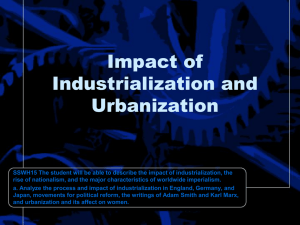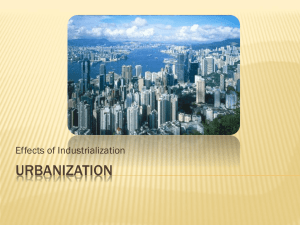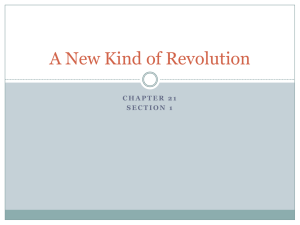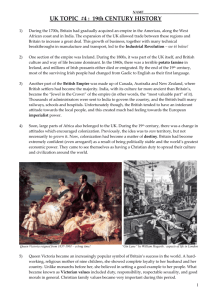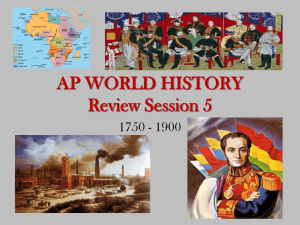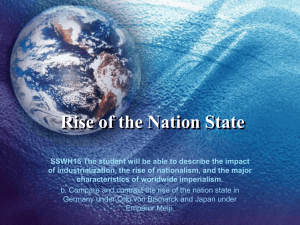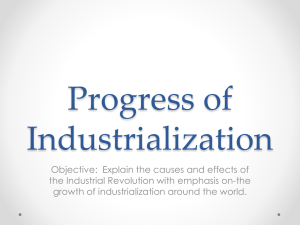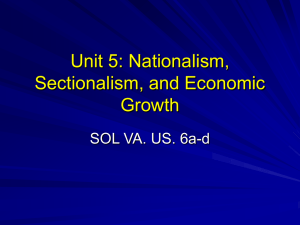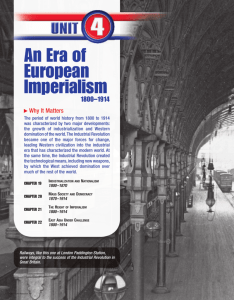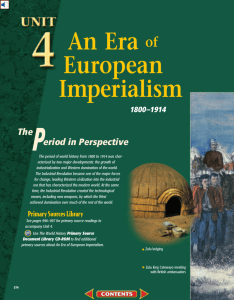Chapter 19: The Beginnings of Modernization: Industrialization and
advertisement
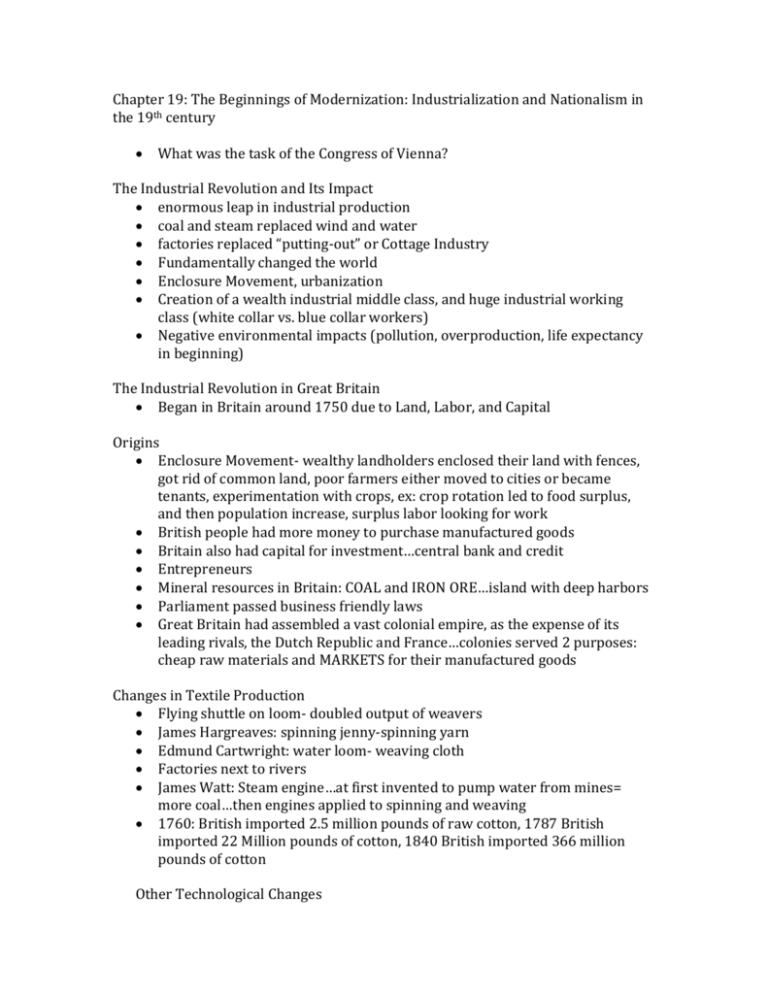
Chapter 19: The Beginnings of Modernization: Industrialization and Nationalism in the 19th century What was the task of the Congress of Vienna? The Industrial Revolution and Its Impact enormous leap in industrial production coal and steam replaced wind and water factories replaced “putting-out” or Cottage Industry Fundamentally changed the world Enclosure Movement, urbanization Creation of a wealth industrial middle class, and huge industrial working class (white collar vs. blue collar workers) Negative environmental impacts (pollution, overproduction, life expectancy in beginning) The Industrial Revolution in Great Britain Began in Britain around 1750 due to Land, Labor, and Capital Origins Enclosure Movement- wealthy landholders enclosed their land with fences, got rid of common land, poor farmers either moved to cities or became tenants, experimentation with crops, ex: crop rotation led to food surplus, and then population increase, surplus labor looking for work British people had more money to purchase manufactured goods Britain also had capital for investment…central bank and credit Entrepreneurs Mineral resources in Britain: COAL and IRON ORE…island with deep harbors Parliament passed business friendly laws Great Britain had assembled a vast colonial empire, as the expense of its leading rivals, the Dutch Republic and France…colonies served 2 purposes: cheap raw materials and MARKETS for their manufactured goods Changes in Textile Production Flying shuttle on loom- doubled output of weavers James Hargreaves: spinning jenny-spinning yarn Edmund Cartwright: water loom- weaving cloth Factories next to rivers James Watt: Steam engine…at first invented to pump water from mines= more coal…then engines applied to spinning and weaving 1760: British imported 2.5 million pounds of raw cotton, 1787 British imported 22 Million pounds of cotton, 1840 British imported 366 million pounds of cotton Other Technological Changes Henry Cort: invented puddling for iron industry…coke, derived from coal, used to burn away impurities in pig iron New high quality wrought iron 1804: Richard Trevithick- first steam powered locomotive (5mph) George Stevenson’s Rocket- first railway line- Liverpool to Manchester…16mph By 1840: Britain had 6,000 miles of railroads The industrial Factory Factory created a new labor system Unskilled labor Child labor Transition of life…clocks…workweek Great Britain: “workshop, banker, and trader of the world” The Spread of Industrialization Began in Great Britain, then spread to Western Europe and the United States Industrialization on the Continent Belgium, German States, France Began after about 1815 Borrowed a lot of British technology Continental Governments more involved in industrialization than in England…funding, oversight, etc Joint-Stock Investment Bank: pooled the savings of thousands of small and large investors- capital put back into economy The Industrial Revolution in the United States 1800 6/8 Americans were farmers 1860- US population from 5 million to 30 million…50% farmers transcontinental railroad Northeast- primary industrial center Most workers in textile and shoe factories were women Growing manufacturing center, abundance of raw materials, and elaborate transportation system: turned US into world’s 2nd largest industrial nation by end of the 19th century Limiting the Spread of Industrialization in the Rest of the World Russia: still largely rural and agricultural- serfdom until 1861 Newly industrialized European states pursued a deliberate policy of preventing the growth of mechanized industry in the areas where they had established control Ex: Cotton industry in INDIA…British East India Company destruction of traditional Indian hand-made cloth (hand spinning wheel) Social Impact of Industrial Revolution Growth of cities and emergence of new social classes Population Growth and Urbanization European population increased dramatically in the 19th century Decline in death rates…plague and smallpox were less frequent Cities and towns grew rapidly Steam engine- urban centers By 1850: more than half of the British population lived in towns and cities Miserable living conditions for many Tenements…5-6 people in one bed Open sewers…human waste Charles Dickens; realism The Industrial Middle Class Bourgeois/ burgher: town dweller…to middle class New industrial middle class (white collar vs. blue collar workers) Bourgeoisie vs. proletariat The Industrial Working Class 12 to 16 hour a day work shifts/ 6 days a week no job security/minimum wage textile mills and coal mines o deformed bodies/ ruined lungs Children- small hands and “delicate touch” for cotton spinning Children made 1/6 to 1/3 what a man did Factory Act of 1833: prohibited employment of children under the age of nine… Children were replaced by women in the workplace New pattern of work based on separation of work and home Did Industrialization bring an Improved Standard of Living? altered the lives of Europeans…left farms, moved to cities, went to factories Was it better? Industrialization increased employment and lowered the price of consumer goods More members of family could work and contribute However, wages were not uniform and jobs were volatile, cramped and unsanitary conditions Middle Class were the real gainers in the Industrial Revolution Efforts at Change Socialism: Marxist analysis of human society (utopian socialists) Robert Owen, British cotton manufactuer…utopian socialist…transformed factory town in Scotland, tried to replicate its success in New Harmony, Indiana, but it didn’t work out Trade Unions: formed by skilled laborers in a number of industries (ex: coal miners and ironworkers) o Strike o Collective bargaining o Largest Union in Britain: Amalgamated Society of Engineers (1851) The Growth of Industrial Prosperity After 1870, Western world experienced a boom in material prosperity New industries, sources of energy, and new goods- believed material progress represented human progress New Products substitution of steel for iron Electricity as new form of energy: heat, light, and motion o Light Bulb (Thomas Edison and Joseph Swan) o Alexander Graham Bell: telephone o Guglielmo Marconi: first radio waves across the Atlantic Internal combustion engine: fired by oil and gasoline o Ocean liners, airplanes, automobiles Henry Ford: mass production of Model T automobile…assembly line Orville and Wilbur Wright first flight in a fixedwing airplane in Kitty Hawk, NC (Mother of Aviation- born in LoCo) New Patterns Industrial production grew rapidly because of increased sale of manufactured goods Germany replaced Britain by 1914 as the industrial leader of Europe Department Stores Emergence of a World Economy Growth of marine transport and railroads International trade increased dramatically Europe dominated the world economy by the beginning of the 20th century The Spread of Industrialization Surge of industrialization in Russia- 1890’s under Sergei Witte, minister for finance…massive railroad construction…rapid growth of modern steel and coal industry…Russia 4th largest producer of steel and ½ world’s production of oil Japan…imperial government took lead in promoting industry…government financed industries, built railroads, brought foreign experts to train Japanese employees…instituted universal education system…key industries in tea, silk, armaments, and shipbuilding Women and Work: New Job Opportunities Working-class women: struggle to define role in society Second Industrial Revolution: new jobs for women…white-collar jobs…clerks, typists, secretaries, telephone operators, teachers, nurses Organizing the Working Classes The Communist Manifesto by Marx and Engels…published in 1848 Marxist Theory Opening words: “the history of hitherto existing society is the history of class struggles” Class Struggle between the Bourgeoisie and the Proletariat Uprising of Proletariat to Socialism to Communism Closing words: “Proletarians of the world, Unite!” Classless society Socialist Parties Workers Parties Revisionism and Trade Unions pure Marxists- revolutionary socialism trade unions won the right to strike Reaction and Revolution: The Growth of Nationalism Industrialization was a major force for change in the 19th century as it led the West into the machine-dependent modern world…nationalism which transformed the political map of Europe in the 19th century The Conservative Order After the defeat of Napoleon, European rulers moved to restore much of the old order Goal of the great powers at the Congress of Vienna- Great Britain, Austria, Prussia, and Russia- Congress of Vienna 1814 o Leader of Congress of Vienna was Austrian Foreign Minister- Austrian foreign minister- Prince Klemens von Metternich (1773-1859) o Claimed he was guided at Vienna by LEGITIMACY- restoring previous ruling families back on throne Ex: France from Napoleon to Louis XVIII (Bourbon monarchy) Ex: Spain- Joseph Napoleon replaced by former family Conservatism- ideology favored organized religion as crucial to social order, hated revolutionary upheavals, and unwilling to accept either the liberal demands for civil liberties and representative governments or the nationalistic aspirations from the French revolutionary era 1815 Concert of Europe- created to maintain the status quo…Great Britain, Russia, Prussia, Austria (later France) agreed to meet periodically in conferences to take steps that would maintain the peace in Europe Intervention: policy to assert rights to send armies into countries where there were revolutions to restore legitimate monarchs to their thrones. Forces for Change Liberalism and Nationalism also at work against conservatism Liberalism: grew from the Enlightenment of 18th century and American and French Revolutions; based on idea that people should be as free from restraint as possible. Politically, liberals came to hold a common set of beliefs o Protection of civil liberties o Basic rights of all people o Equality before the law o Freedom of assembly, speech, and the press o Freedom from arbitrary arrest o Protection through American Bill of Rights or French Declaration of Rights of Man the Citizen o Most liberals advocated separation of church and state o Right of peaceful opposition to the government o Making of laws by a representative o Many liberals believed in constitutional monarchy Liberals were NOT democrats…thought right to vote and hold office should be open only to men who owned property. o Liberals also believed in LAISSEZ-FAIRE principles rejected state interference in the regulation of wages and work hours o Liberals were mostly middle-class men, especially the industrial bourgeoisie Nationalism: even more powerful ideology for change in the 19th century o Common institutions, traditions, language, and customs o “nation” as focus of the individual’s primary political loyalty o Belief that each nationality should have its own government o Ex: German unity…but Hungarians wanted their own nation Nationalism: threat to the existing political order…especially from the Congress of Vienna 1815 Revolution and Reform, 1830-1832 The Revolutions of 1848 Revolution in Central Europe Revolts in the Italian States Nationalism in the Balkans: The Ottoman Empire and the Eastern Question The Crimean War National Unification and the National State, 1848-1871 The Unification of Italy The Unification of Germany Nationalism and Reform: The European National State at Mid-Century Great Britain France The Austrian Empire Russia The European State, 1871-1914 Western Europe: The Growth of Political Democracy Central and Eastern Europe: Persistence of the Old Order International Rivalries and the Winds of War The Ottoman Empire and the Nationalism in the Balkans Crisis in the Balkans, 1908-1913
